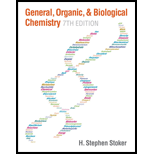
(a)
Interpretation:
The structure of carbonyl-containing compound that is obtained when the given amide undergoes acidic hydrolysis has to be drawn.
Concept Introduction:
Amides are derivatives of
Acidic hydrolysis of amides gives the product as carboxylic acid and

Basic hydrolysis of amides gives the product as carboxylic acid salt and amine. Carboxylic acid salt is obtained because in basic conditions the carboxylic acid is converted into carboxylic acid salt.

(b)
Interpretation:
The structure of carbonyl-containing compound that is obtained when the given amide undergoes acidic hydrolysis has to be drawn.
Concept Introduction:
Amides are derivatives of carboxylic acid. Amides are not much reactive as of carboxylic acids. They are also stable relatively in aqueous solution. But under strenuous conditions amides undergo hydrolysis. The conditions are presence of acid, base or enzymes.
Acidic hydrolysis of amides gives the product as carboxylic acid and amine salt. Amine salt is obtained because in acidic conditions the amine is converted into amine salt.

Basic hydrolysis of amides gives the product as carboxylic acid salt and amine. Carboxylic acid salt is obtained because in basic conditions the carboxylic acid is converted into carboxylic acid salt.

(c)
Interpretation:
The structure of carbonyl-containing compound that is obtained when the given amide undergoes acidic hydrolysis has to be drawn.
Concept Introduction:
Amides are derivatives of carboxylic acid. Amides are not much reactive as of carboxylic acids. They are also stable relatively in aqueous solution. But under strenuous conditions amides undergo hydrolysis. The conditions are presence of acid, base or enzymes.
Acidic hydrolysis of amides gives the product as carboxylic acid and amine salt. Amine salt is obtained because in acidic conditions the amine is converted into amine salt.

Basic hydrolysis of amides gives the product as carboxylic acid salt and amine. Carboxylic acid salt is obtained because in basic conditions the carboxylic acid is converted into carboxylic acid salt.

(d)
Interpretation:
The structure of carbonyl-containing compound that is obtained when the given amide undergoes acidic hydrolysis has to be drawn.
Concept Introduction:
Amides are derivatives of carboxylic acid. Amides are not much reactive as of carboxylic acids. They are also stable relatively in aqueous solution. But under strenuous conditions amides undergo hydrolysis. The conditions are presence of acid, base or enzymes.
Acidic hydrolysis of amides gives the product as carboxylic acid and amine salt. Amine salt is obtained because in acidic conditions the amine is converted into amine salt.

Basic hydrolysis of amides gives the product as carboxylic acid salt and amine. Carboxylic acid salt is obtained because in basic conditions the carboxylic acid is converted into carboxylic acid salt.

Want to see the full answer?
Check out a sample textbook solution
Chapter 17 Solutions
GENERAL,ORGANIC,+BIO.CHEM.-MINDTAP
- Fumaric acid is a metabolic intermediate that has the systematic name trans-2-butenedioic acid. Draw its structure.arrow_forwardwrite the structure of the following disaccharides ex: Beta- D- Galactopyranosyl- alpha-D-glucosearrow_forwardGive one specific sample structure (Fischer Projection or Haworth) of the following carbohydrate derivatives: - Alditols - Deoxy-sugararrow_forward
- Given the structure of disaccharide below: (a) is it reducing? (b) will it react positively with Benedict's reagent and (c) what specific glycosidic linkage is the name of the disaccharide?arrow_forwardThe following structure is sorbose Answer the following questions and briefly explain Draw β-D-sorbufuranose Draw β-D-sorbufuranosyl(2->1) β-D-glucopyranoside. Is this reducing sugar? What would be the probable function of this disaccharide, structural or storage?arrow_forwardWhich of the following is the correct systematic name of the disaccharide shown? OH он но но но- OH Он a-D-glucopyranosyl-(1-3)-B-D-galactopyranose O a-D-glucopyranosyl-(1–3)-B-D-glucopyranose O a-D-gulopyranosyl-(1-4)-B-D-glucopyranose O a-D-gulopyranosyl-(1-4)-B-D-galactopyranosearrow_forward
- Draw condensed structural formulas for all products obtained from the complete hydrolysis of the following triacylglycerol.arrow_forwardA reducing sugar will undergo the Fehling reaction, which requires a (potential) free aldehyde group. Which of the disaccharides as shown are reducing and which are nonreducing?arrow_forwardGiven the structure of disaccharide below: (a) is it reducing or non-reducing?(b) will it react positively with Benedict's reagent and (c) what specific name of glycosidic linkage of the disaccharide is given?arrow_forward
- Indicate whether each of the following monosaccharides would be classified as an aldose, ketose, triose, tetrose, pentose, or hexose (each can be classified into two different categories). Which of these sugars would exist predominantly in the cyclic form?arrow_forwardDraw the keto or enol tautomer for each of the following compounds when they were treated with traces of acids or bases. CH3 OH (1) ? H H (2) CH₂CH₂ C=C₂ CH3 ?arrow_forwardDraw the structures of the following compounds. (Includes both new and old names.) 3-cyclopentylhexan-3-olarrow_forward
 Human Anatomy & Physiology (11th Edition)BiologyISBN:9780134580999Author:Elaine N. Marieb, Katja N. HoehnPublisher:PEARSON
Human Anatomy & Physiology (11th Edition)BiologyISBN:9780134580999Author:Elaine N. Marieb, Katja N. HoehnPublisher:PEARSON Biology 2eBiologyISBN:9781947172517Author:Matthew Douglas, Jung Choi, Mary Ann ClarkPublisher:OpenStax
Biology 2eBiologyISBN:9781947172517Author:Matthew Douglas, Jung Choi, Mary Ann ClarkPublisher:OpenStax Anatomy & PhysiologyBiologyISBN:9781259398629Author:McKinley, Michael P., O'loughlin, Valerie Dean, Bidle, Theresa StouterPublisher:Mcgraw Hill Education,
Anatomy & PhysiologyBiologyISBN:9781259398629Author:McKinley, Michael P., O'loughlin, Valerie Dean, Bidle, Theresa StouterPublisher:Mcgraw Hill Education, Molecular Biology of the Cell (Sixth Edition)BiologyISBN:9780815344322Author:Bruce Alberts, Alexander D. Johnson, Julian Lewis, David Morgan, Martin Raff, Keith Roberts, Peter WalterPublisher:W. W. Norton & Company
Molecular Biology of the Cell (Sixth Edition)BiologyISBN:9780815344322Author:Bruce Alberts, Alexander D. Johnson, Julian Lewis, David Morgan, Martin Raff, Keith Roberts, Peter WalterPublisher:W. W. Norton & Company Laboratory Manual For Human Anatomy & PhysiologyBiologyISBN:9781260159363Author:Martin, Terry R., Prentice-craver, CynthiaPublisher:McGraw-Hill Publishing Co.
Laboratory Manual For Human Anatomy & PhysiologyBiologyISBN:9781260159363Author:Martin, Terry R., Prentice-craver, CynthiaPublisher:McGraw-Hill Publishing Co. Inquiry Into Life (16th Edition)BiologyISBN:9781260231700Author:Sylvia S. Mader, Michael WindelspechtPublisher:McGraw Hill Education
Inquiry Into Life (16th Edition)BiologyISBN:9781260231700Author:Sylvia S. Mader, Michael WindelspechtPublisher:McGraw Hill Education





